
|   |

|   |
 e-mail: leelakaverivenkat@gmail.com Registering ten years of Nrityantar with Naman 2019 Photos: R Dashrath August 18, 2019 Established ten years ago by Odissi dancer Madhulita Mohapatra, Nrityantar in Bengaluru has earned much goodwill through hard work and the dancer's low key bearing - the open minded Bangaloreans taking to Odissi like ducks to water. Naman 2019, the institution's annual magnum opus festival mounted at Bengaluru's ADA Rangamandira, for this critic, had some of its most rewarding moments in the interactions involving dance writers, scholars, practitioners and youngsters. The organisational work behind this very efficiently managed three day event proved how professional dancers running institutions have taken to multi tasking very effectively, mounting large events, with minute details attended to carefully. For once, one had fine comperes for Naman 2019 on all the days in Akila Venkat, Meghna Das and Anjali Raj Urs. Madhulita's generosity in including in the programme dancers from other Odissi institutions based in different places in India provides a variety of Odissi gharanas, while making this an occasion for interaction amongst the larger Odissi community. The take-off point came from the junior-most students on the first evening, with understandably varying degrees of proficiency. When students danced to the Kannada lyric "Hari smaraneya mado, Nirantara" with fine group arrangements, one saw how sahitya in the regional language where the school is based, makes not just an effective way of reaching out to the people, but proves again the universal appeal of the Dasa Padas. The Malhar Pallavi, a composition of Bijay Kumar Jena, was neatly rendered. While the rhythmic part in all compositions were executed with confidence, time and experience will make for more flawless preservation amidst movement, of the body meridian (imaginary line running from head to toes dividing body into two halves), while executing the bhangis. Superb solo execution of Surupa Sen's adaptation of what was an original Kelucharan choreography in the Mohana Pallavi was by young dancer Akshati, showing up again the perfection of Odissi grooming in the Nrityagram trained students - the dancer now joining Nrityantar. 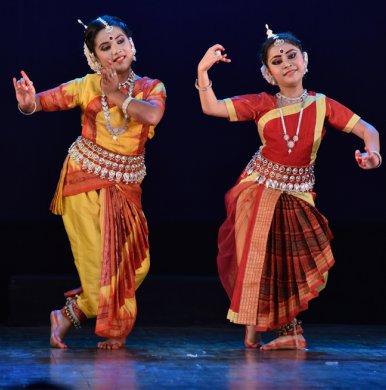 Angeleena Avnee & Prisha Sinha 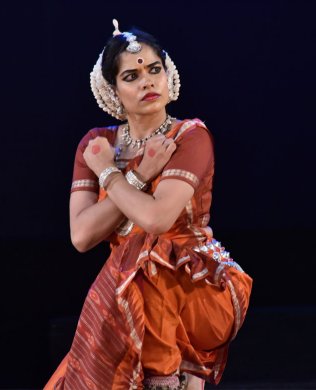 Madhulita Mohapatra Madhulita's choreography of Varsha, set to raga Megh, with the rhythmic inputs by Bijay Kumar Barik, visualised the scenic delights of the monsoon season including the ubiquitous dance of the peacock. Starting with damaru percussion, Madhulita's work 'Shivam Dhemahi' with Nityananda Mishra's poetry and music by Sukant Kumar Kundu portrayed the powerful 'neelakantha' who swallowed the accumulated poison caused by Vasuki's breath while the ocean was churned for ambrosia by the Gods and Demons, and who saved Mrityunjay from Yama's noose, the item showing the more fearsome aspects of Shiva. Madhulita's interpretation of the ashtapadi, as visualised by her teacher Aruna Mohanty, "Ramate Yamunapulinavane vijayi murariradhuna" set to raga Pilu by Dr. Subas Pani, portrayed Radha's anguished jealousy visualising Krishna in love play with another cowherdess - sensitively caught in the rendition with internalised depth in emotions very much in the guru's style. A highlight was Binod Bihari Panda's lyric presented as a duet 'Radha Rani' by the very young Angeleena Avnee as the beauteous Radha and Prisha Sinha as Krishna - Angeleena's precocious movement and interpretative range finding a perfect partner in the caring Krishna, the total picture fitting the words of the song "Aha ki sundara dise" (Oh, what a beautiful sight) with every viewer's inside joining the "Talanke Takadhini" joyous jig as finale. Specially crafted for the occasion, Nityananda Mishra's libretto on three manifestations of the Devi as 'Mandaramalini Manikeswari', Chamundeshwari and Durgeshwari with Sukanta Kumar Kundu's musical score including both folk ditties and classical ragas, along with Dhaneswar Swain's inimitable rhythm patterns, became a combination of grace and power. Manikeswari as Mandaramalini was the rural Goddess, Chamundeshwari had the blended character of compassion with ferocity and Durga as Shankari and Bhuvaneswari exuded fearsome power. In different attitudes, the item was well set by Madhulita with the student group performing with involvement. 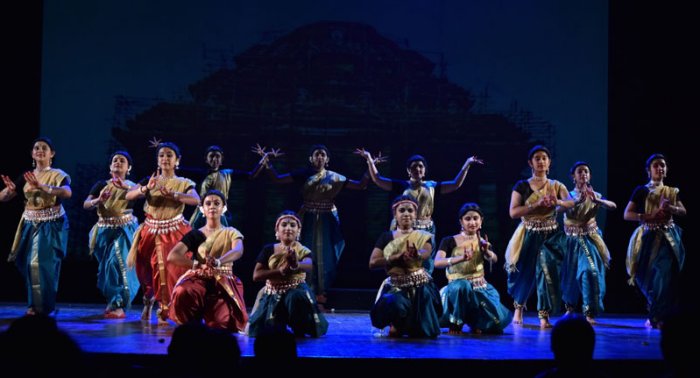 'Legend of Dharmapada' by young students of Nrityantar The short dance drama based on the Legend of Dharmapada had music composed by Satyabrata Katha and rhythmic contributions by Ajay Kumar Choudhary and Soubhagya Narayan Chhotray with Madhulita's choreography. The work was woven round the tragic legend associated with the Konark temple when young twelve year old Dharma set off on the quest to meet his hitherto never seen father Bisu Maharana, the chief sculptor of the Konark temple, as ordered by King Narasimhadeva. Travelling for days to finally arrive to a joyous union with the father, Dharma soon sensed hidden tension in the workers who could face death, if the temple was not completed in the stipulated time - for after doing most of the work the herculean unsolved problem remained of mounting the temple tower top with the massive lotus shaped finial as the amalaka - on which the mounted flagstaff would have the King's victorious flag fluttering. Young Dharma's sharp intelligence soon fixed the problem and the work was done. But to spare the sculptors who faced certain death when the king realised how a youngster had accomplished what all the experienced hands had failed to do, young Dharma jumped to his death from the finial into the ferocious waters of Chandrabhaga river flowing underneath. Madhulita's simple and to the point dance visualisation with Angeleena as Dharma and father Bishumaharana enacted by Aarushi Patnaik, had conviction in the presentation by the students. Mirza and Sahiba, the latest production with Madhulita as Savini (Sahiba) and Paridi Joshi as the excellent horseman and archer Manhar (Mirza), was a simple love story with a tragic end - the lovers thwarted by Savini's evil brother ending with Manhar being killed and Savini committing suicide. The textual framework in Odiya poetry was the work of Kedar Mishra, with Nityananda Mishra also helping out with some suggestions. Musician Sukant Kundu and percussionist Dhaneswar Swain conceived of the music and rhythm respectively. Despite some regaling sequences, the exaggerated dance treatment detracted from the presentation. One must admit that with unselfconscious ease, the very attractive Paridhi Joshi with her high vaulting and somersaulting steps played the male role of Manhar. The romantic tone of "Gotti dharana geeta" and "gottiya phollaro base" (singing the same tune and carrying the smell of one flower), became over indulgent towards the finish. Actually, words are superfluous at the end, when actions (somewhat overdone) speak for themselves. Ultimately it becomes the usual boy/girl love story too reminiscent of the film. Predictably the general public loved it! 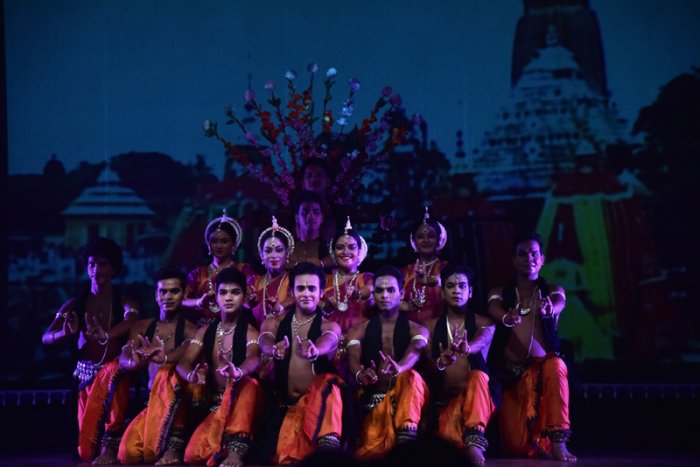 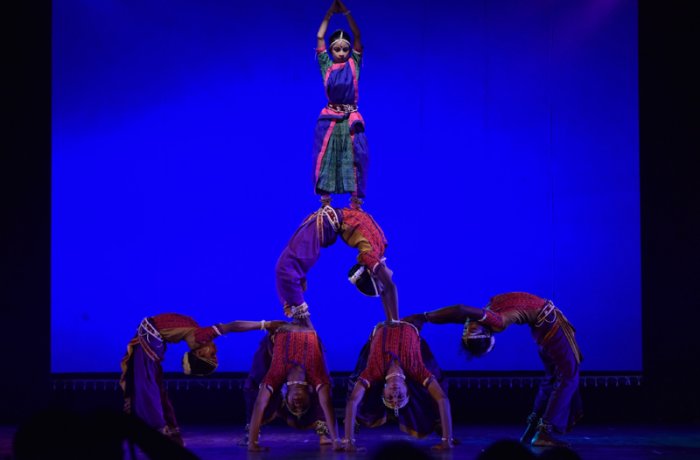 'Amazing Odisha' by Orissa Dance Academy Choreographed by Aruna Mohanty, a mosaic of Orissan history and culture in "Amazing Odisha" by Orissa Dance Academy in an amalgam of Odissi, Chhau, Gotipua, Geeti Natya, tribal rhythms and what have you, stole the show with its finished dancers and excellent grafting of scenes. Chandan Jatra in Summer, Folk dances surrounding harvest, Ratha Jatra, snippets of tribal dance, glimpse of the hunter in Chhau dance, the Bheetar Gaoni in her "Jooda Bandilo" song, the Mahari dancing before Jagannatha, Balabhadra and Subhadra from which Mangalacharan has finally evolved, delightful bandha nritya by the Gotipuas, snippets of the 'tarijham' Shankarabharanam Pallavi of Kelucharan Mohapatra to heroines like Kunti and Draupadi on to Nirbhaya (all highly wronged women) highlighting the message of woman fighting against injustice, to the final Devi slokam and the patriotic "Utkala Janani." With such strong dancers and well edited scenes, the screened visuals of wild life and other scenes on the backdrop only distracted. After such a show, Sharmila Mukerjee's Sanjali group presenting Yaman Pallavi ending with Ganga slokam looked somewhat tame. 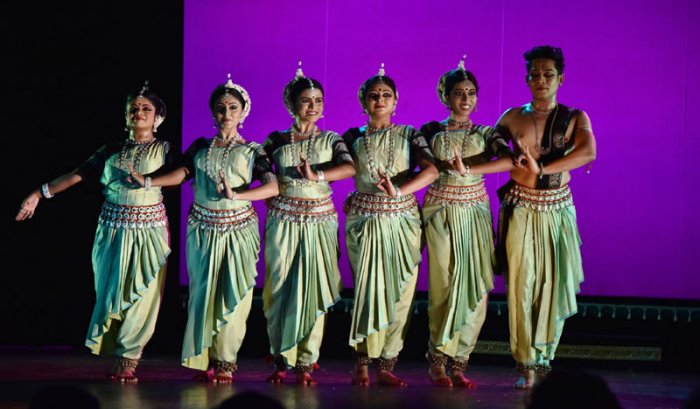 Sanjali ensemble 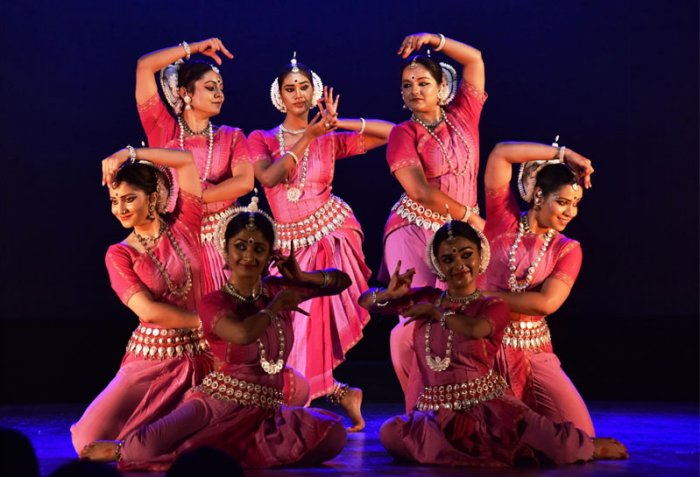 Malhar Pallavi by Nrityantar ensemble The Panel Meet in the Mount Carmel College auditorium turned out to be a spirited event, moderated with excellent precision and understanding by Sahana Das. "We are told that classical dances, stemming from the past do not and cannot change. Watching the film on dancer Mrinalini Sarabhai (courtesy Dr. Sunil Kothari), we found her latest works aimed at focussing on contemporary issues, very different from Bharatanatyam. How far can experimentation go, and do we still identity the dance as Bharatanatyam?" The issue posed by one of the young students at Mount Carmel College brought out the crux of Globalisation of Dance, and its challenges for what we decipher as the classical dance forms. With all the clamour, competition with Bollywood and changes effected by the need to reach out to a contemporary audience, at what point does the particular dance lose its identity and right to be categorised under a particular classical tradition? "If dance calling itself Odissi does not reflect the Odishan sensibility (which is a felt and experienced entity not to be explained in cold words), how does one recognise it as Odissi?" is how one writer/scholar from Odisha put it. How does one lay down the aesthetic contours and even the 'auchitya' of various aspects of dance in this globalised variety? While excellence should decide what dance should be, vast mediocrity which has the right to live and express itself should not be denied its space, while not being allowed to overwhelm and dictate the norm. What is the role of a writer on dance in the present circumstances? While not denying mediocrity its space to exist, can he just become the eternal 'Do-gooder' encouraging even poor dancing? He is not running a charitable trust but is meant to highlight real talent through objective writing which tells the truth without hurting the less talented. There were other issues about whether dance could live in this economic oriented world without being able to reach out to an audience. Is it right for a dance critic to become a promoter through festivals providing performance space to young dancers? Acquiring information and knowledge is a must for dancers to sprout new ideas for production. But when print journals on dance, with no takers, are folding up, where does the one interested in acquiring information go? One was happy to see that youngsters learning the dance are interested and also bold enough to ask questions about various aspects. I was happiest listening to Sahana Das when she said that she was not aiming at awakening young college minds to classical dance to make them dancers – but more importantly to groom youngsters who will become part of the audience which classical dance so badly needs today. Ultimately, while the events were well attended – the audience comprised students and their parents. Where are the new audiences that classical dance sorely needs?  Writing on the dance scene for the last forty years, Leela Venkataraman's incisive comments on performances of all dance forms, participation in dance discussions both in India and abroad, and as a regular contributor to Hindu Friday Review, journals like Sruti and Nartanam, makes her voice respected for its balanced critiquing. She is the author of several books like Indian Classical dance: Tradition in Transition, Classical Dance in India and Indian Classical dance: The Renaissance and Beyond. Post your comments Please provide your name and email id when you use the Anonymous profile in the blog to post a comment. All appropriate comments posted with name & email id in the blog will also be featured in the site. |